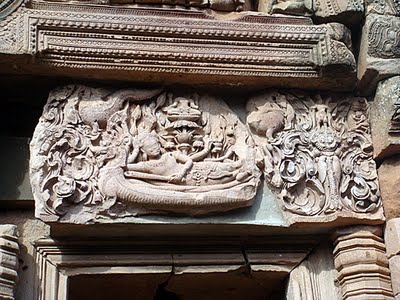Vishnu reclining
The east doorway to the central sanctuary of the temple of Prasat Phnom Rung hosts the most famous lintel in Thailand, and not necessarily for all the right reasons. Before the restoration of the temple by the Thai authorities began in 1972 and lasted through til 1988, the lintel disappeared sometime in the 1960s, later to be found residing in the Art Institute of Chicago, in the United States. As the temple's restoration neared completion, demands for the return of the lintel were voiced and eventually the iconic piece was returned and replaced in its original location in 1988 (in exchange for a payment to the American foundation and temporary loans of artifacts - nothing is free in this world). Despite a missing left edge and being broken in two pieces, this is one of the finest displays of this well-known Hindu scene - Vishnu Anantasayin. Vishnu is shown reclining on his right side on the back of the naga serpent, Ananta with Brahma rising from Vishnu on a lotus flower while Lakshmi cradles his legs. Also in the scene are hamsas, kala faces eating garlands and two elegant parrots. There is a very well compiled museum at Phnom Rung which tells the story of the temple and its restoration in great detail and is a perfect example of how much time and effort the Thai authorities have put in to make the experience of visiting the temple sites, a well-rounded one. I was very impressed.
The question of lost antiquities and their ownership is a big topic which I won't attempt to cover here in detail, besides making a few points. Khmer artifacts can be found all over the world, either in museums or private collections. They were of course once resident in Cambodia and the Khmer Empire but under varying guises, have been spirited away to the far corners and few show little sign of coming home. The permanent return of these items seems off the agenda with the big museums such as the Guimet in Paris, whilst loans may be a possible way forward. Many Khmer artifacts were removed from their original location during the colonialism of Cambodia by France. For some museum owners the idea of them being returned to their country of origin is a non starter. "We do not see the return of objects that were acquired honestly 100 years ago as constructive. Especially as they are established and accessible institutions that are open to the public that house them. As in most things, one can't readdress the circumstances of history in objects acquired before 1970. I hope the museums of the 21st century and countries in the 21st century will be able and open to sharing objects for short or long periods of time. In this vision there would be a clear acceptance of governmental or institutional ownership, but there would an ever lessening emphasis on objects representing only the clear identity of specific people or nations," says Michael Conforti, president of the Art Museum Directors in the USA. Well, he would say that wouldn't he, promoting the notion of the universal museum in the 21st century, rather than having to give up items that were often acquired in murky circumstances. It's a debate that will rage on regardless.
The question of lost antiquities and their ownership is a big topic which I won't attempt to cover here in detail, besides making a few points. Khmer artifacts can be found all over the world, either in museums or private collections. They were of course once resident in Cambodia and the Khmer Empire but under varying guises, have been spirited away to the far corners and few show little sign of coming home. The permanent return of these items seems off the agenda with the big museums such as the Guimet in Paris, whilst loans may be a possible way forward. Many Khmer artifacts were removed from their original location during the colonialism of Cambodia by France. For some museum owners the idea of them being returned to their country of origin is a non starter. "We do not see the return of objects that were acquired honestly 100 years ago as constructive. Especially as they are established and accessible institutions that are open to the public that house them. As in most things, one can't readdress the circumstances of history in objects acquired before 1970. I hope the museums of the 21st century and countries in the 21st century will be able and open to sharing objects for short or long periods of time. In this vision there would be a clear acceptance of governmental or institutional ownership, but there would an ever lessening emphasis on objects representing only the clear identity of specific people or nations," says Michael Conforti, president of the Art Museum Directors in the USA. Well, he would say that wouldn't he, promoting the notion of the universal museum in the 21st century, rather than having to give up items that were often acquired in murky circumstances. It's a debate that will rage on regardless.
Labels: Phnom Rung



0 Comments:
Post a Comment
<< Home